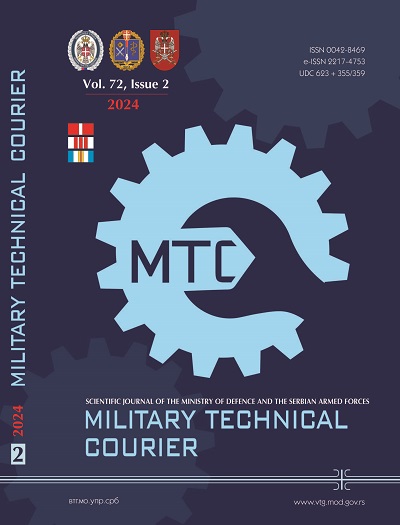Rheology properties of bitumen binders with various fillers
Abstract
Introduction: The resistance of road surfaces to the formation of a longitudinal wear mark from passing vehicles at the present stage is one of the most pressing problems in the field of asphalt concrete coatings. Therefore, the search for a solution to this problem constantly continues, including studying the behavior of various components of asphalt concrete mixtures when they are loaded.
Methods: The studies were carried out under static load in three temperature modes: 25°C, 40°C and 50°C, as well as using the standard DSR (dynamic shear rheometer) method at temperatures above 70°C. Two types of bitumen were used as binders: semi-blown petroleum road bitumen BND 100/130 and polymer bitumen binder PmB 90. Various fine fillers were introduced into their composition: marble dust, rubber crumbs and modified powder obtained by simultaneous grinding of marble with polyethylene.
Results: It was found that a fine filler has a stronger effect on creep than a change in the grade of asphalt concrete binder. The lowest creep and the greatest shear resistance in the entire temperature range of measurements were shown by an asphalt binder based on a powder obtained by joint grinding of marble and polyethylene.
Conclusions: The effect of a fine filler on the creep of a bitumen binder may exceed the effect associated with a change in the type of bitumen binder. It is obvious that it is the fine filler that has a greater effect on the stability of asphalt concrete to the formation of ruts than conventional semi-blown bitumen binders.
References
Abdulmajeed, S.G. & Muniandy, R. 2017. The Effect of Binder Type and Temperature Differential on The Rutting Performance of Hot Mix Asphalt. International Journal of Applied Engineering Research, 12(17), pp.6841-6852 [online]. Available at: https://www.ripublication.com/ijaer17/ijaerv12n17_73.pdf [Accessed: 20 December 2023].
Ai, U., Sharp, K.G. & Trevorrow, N. 2017. Heavy vehicle horizontal stresses and pavement surface performance. TRID [online]. Available at: https://trid.trb.org/View/1485226 [Accessed: 20 December 2023]. ISBN: 9781925671001.
Akisetty, C.K., Lee, S.-J. & Amirkhanian, S.N 2009. High temperature properties of rubberized binders containing warm asphalt additives. Construction and Building Materials, 23(1), pp.565-573. Available at: https://doi.org/10.1016/j.conbuildmat.2007.10.010.
Alekseenko, V.V., Vabishchevich, K.Yu. & Verkhoturova, E.V. 2019. Modeling of Asphalt Concrete While Using Discrete Element Method. Science and Technique, 18(2), pp.171-180. Available at: https://doi.org/10.21122/2227-1031-2019-18-2-171-180.
Arun Kumar, U. & Satyanarayana, P.V.V. 2015. Comparison of the Polyethylene and SBS Polymer Modi-fied Bitumen’s Effect – A Case Study. International Journal of Engineering Trends and Tech-nology (IJETT), 22(7), pp.325-330. Available at: https://doi.org/10.14445/22315381/IJETT-V22P268.
Bodin, D. 2017. Improved laboratory characterisation of the deformation properties of granular materials. TRID [online]. Available at: https://trid.trb.org/View/1485223 [Accessed: 20 December 2023]. ISBN: 9781925451993.
Hou, S., Zhang, D., Huang, X. & Zhao, Y. 2015. Investigation of micro-mechanical response of asphalt mixtures by a three-dimensional discrete element model. Journal of Wuhan University of Technology-Mater. Sci. Ed., 30, pp.338-343. Available at: https://doi.org/10.1007/s11595-015-1150-5.
Ibrahim, A.-H.A. 2019. Laboratory investigation of aged HDPE-modified asphalt mixes. International Journal of Pavement Research and Technology, 12, pp.364-369. Available at: https://doi.org/10.1007/s42947-019-0043-y.
Lira, B., Ekblad, J. & Lundström, R. 2019. Evaluation of asphalt rutting based on mixture aggregate gradation. Road Materials and Pavement Design, 22, pp.1-18. Available at: https://doi.org/10.1080/14680629.2019.1683061.
Ma, T., Zhang, D., Zhang, Y., Wang, S. & Huang, X. 2018. Simulation of wheel tracking test for asphalt mixture using discrete element modelling. Road Materials and Pavement Design, 19(2), pp.367-384. Available at: https://doi.org/10.1080/14680629.2016.1261725.
Okhotnikova, E.S., Frolov, I.N., Ganeeva, Yu.M., Firsin, A.A. & Yusupova, T.N. 2019. Rheological behavior of recycled polyethylene modified bitumens. Petroleum Science and Technology, 37(10), pp.1136-1142. Available at: https://doi.org/10.1080/10916466.2019.1578796.
Olsson, E., Jelagin, D. & Partl, M. 2019. New discrete element framework for modelling asphalt com-paction. Road Materials and Pavement Design, 20, pp.5604-5616. Available at: https://doi.org/10.1080/14680629.2019.1633750.
Qian, C., Fan, W., Yang, G., Han, L., Xing, B. & Lv, X. 2020. Influence of crumb rubber particle size and SBS structure on properties of CR/SBS composite modified asphalt. Construction and Building Materials, 235, art.number:117517. Available at: https://doi.org/10.1016/j.conbuildmat.2019.117517.
Copyright (c) 2024 Viktor Alekseenko, Elena Verkhoturova, Roman Zhitov, Dmitry Nebratenko

This work is licensed under a Creative Commons Attribution 4.0 International License.
Proposed Creative Commons Copyright Notices
Proposed Policy for Military Technical Courier (Journals That Offer Open Access)
Authors who publish with this journal agree to the following terms:
Authors retain copyright and grant the journal right of first publication with the work simultaneously licensed under a Creative Commons Attribution License that allows others to share the work with an acknowledgement of the work's authorship and initial publication in this journal.
- Authors are able to enter into separate, additional contractual arrangements for the non-exclusive distribution of the journal's published version of the work (e.g., post it to an institutional repository or publish it in a book), with an acknowledgement of its initial publication in this journal.
- Authors are permitted and encouraged to post their work online (e.g., in institutional repositories or on their website) prior to and during the submission process, as it can lead to productive exchanges, as well as earlier and greater citation of published work (See The Effect of Open Access).

